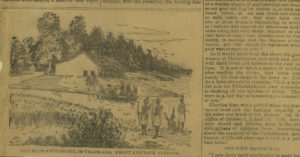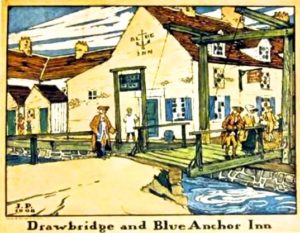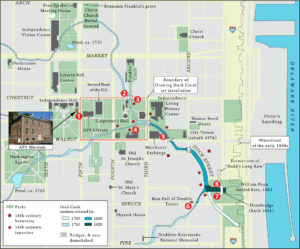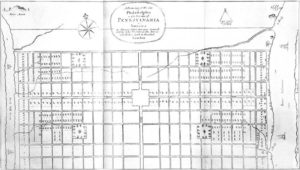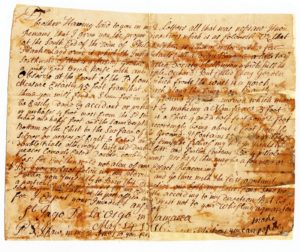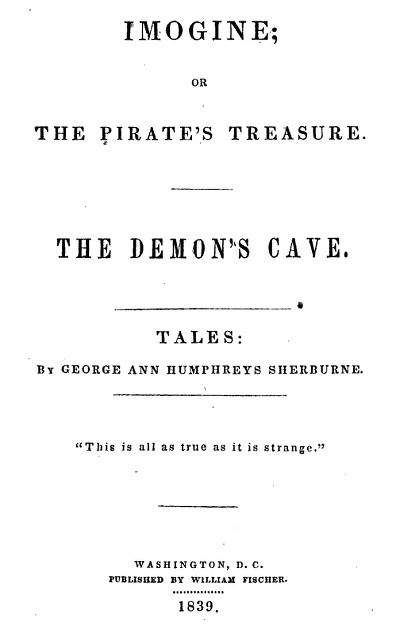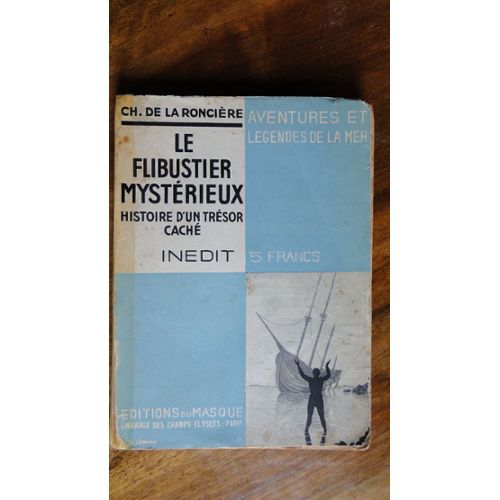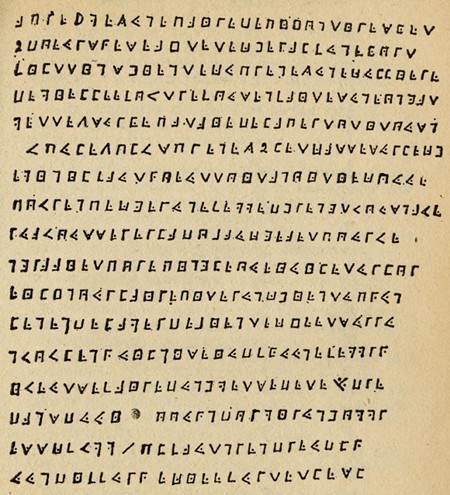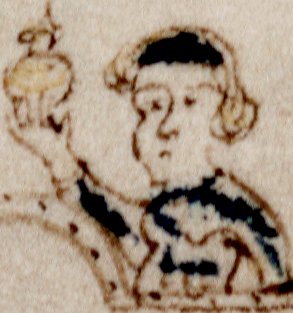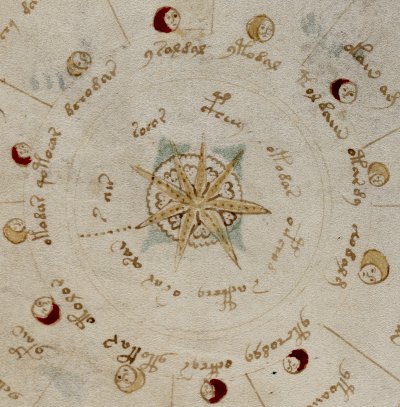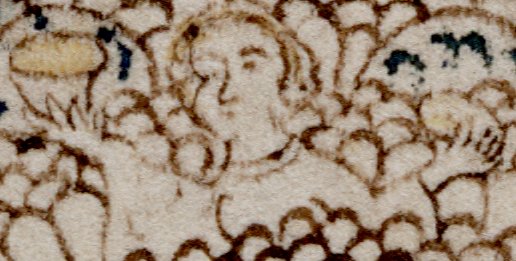Following on from the 1716 treasure map letter I posted about a few days ago, it’s now time for a Cipher Mysteries historical saunter through Philadelphia. And why not?
The Blue Anchor Inn
“…at the South End of the town of Philadelphia is a Gutt of water with a few Planks Layd over it which the Inhabitants call a drau Bridge:…”
The history of Philadelphia begins with William Penn landing at the Blue Anchor Inn in 1682/1683: liking the dock and the creek beside it, he decided that this was where a “Greene Countrie Towne” should be built, between the Delaware and Schuylkill Rivers. Here’s an old newspaper reconstruction of what the Inn originally looked like:
Before very long (1691 is claimed), a drawbridge was erected across Dock Creek to allow boat access to the little harbour and foot access to the quickly growing city. Here’s a 1908 illustration by James Moore Preston (courtesy of blog page Early Philadelphia Inns and Taverns: Part 2:
Though far less colourful, Frank Hamilton Taylor’s (1922) drawing tells much the same story:
Dock Creek
Philly H20: The History of Philadelphia’s Watersheds and Sewers notes that “For many years after the creek was covered over the neighborhood was known as the “Drawbridge,” and as late as 1834 we read that the Drawbridge lot rented for $600 per year.”
Dock Creek was subsequently covered over for the simple reason that everyone put their sewage into it (and so it stank to high heaven). In the last few years, however, it has been (virtually) reclaimed by artists and historians, in the form of a walk along its former course being set out as an Art Installation by Winifred Lutz. The following nice map also shows the breweries and tanneries set up beside the creek, tipping their noxious wastes away:
Society Hill
“…a little to ye Southward of that is a Rising Ground called Society Hill…”
As noted in The Pennsylvania magazine of history and biography, Vol. XLVII (1923), this area was first settled in the early 1680s by The Free Society of Traders…
[…] which in 1682 was granted a charter by William Penn, and soon set up a warehouse and office in the infant city, on the west side of Front Street, near the south side of Dock Creek. It was located at the foot of the hill known as Society Hill and thence its city tract of about one hundred acres extended westerly in a tier of lots from Front Street on the Delaware to Front Street on the Schuylkill River. A map of the surveyor Thomas Holme made about 1683 shows its location.
Thomas Holme was William Penn’s surveyor general, and his map (which I found here) looked like this:
Hence Society Hill sat right at the heart of Philadelphia’s early history, though the Society it was named after closed in March 1723. Robert Morris Skaler’s (2005) “Society Hill and Old City” seems to be a pretty definitive reference on this subject (the first 33 pages are on Google Books), but I’m waiting for my copy to arrive in the post. 😉
All the same, Society Hill completely lost its shine during the nineteenth century, as fashion moved the City’s Centre ever westwards: many of the neighbourhoods turned into appalling slums, with W.E.B.Dubois’s famous (1899) sociological study “The Philadelphia Negro” focused on the City’s Seventh Ward, the long thin rectangle running West of the lower half of Society Hill all the way to the Shuylkill River. By the 1940s, the Hill was in almost complete disrepair.
And yet since then, the modern history of Society Hill is a rather strange thing. The area was consciously refashioned into Colonial-era kitsch, where rich owners with salvageable homes were given low-interest loans to make them nice again, poor owners were kicked out and their houses sold on to rich owners to salvage, and everything else was flattened and turned into Colonial retro townhouses. Brick pavements and faux-old streetlights added to the overall Disneyfication: the newly fictionalized Society Hill became a film set, populated by the genteel. (The 1770-era [but internally modernized] townhouse at 232 Spruce Street went on sale in 2017 for $899,000.) And now, while Philadelphia’s demographics are getting younger, Society Hill’s demographics are getting older, richer and whiter: so as neighbourhoods go, it’s a curious socio-economic and real-estate bubble that the City consciously inflated.
Just so you don’t get too taken in by it all if you happen to go on a walking tour. 🙂
Cherry Garden
“…upon which hill is a pretty good Brick house with one apple Orchard: But called Cherry Garden…”
According to an entry in the online Philadelphia Encyclopaedia, William Penn’s intention for the town was for each plot to comprise at least half an acre, with the house placed right in the middle, so that “there may be ground on each side for Gardens or Orchards, or fields”. The entry continues:
A number of wealthy Philadelphians did create gardens in their large city lots, as well as at their country estates outside the original city limits, and many Philadelphians visited these gardens in the eighteenth and nineteenth centuries. […] The first early gardens fully accessible to the (paying) public in the city, however, were associated with entertainment and refreshment rather than science and education. These included the “Cherry Garden” in the area that later became known as Society Hill […]
John Fanning Watson’s (1830) “Annals of Philadelphia and Pennsylvania in Olden Time” mentions this explicitly:
“Society Hill”, a name once so prevalent for all the region south of Pine street, even down to the Swedes’ church, has been discontinued for the last sixty-eight or seventy-eight years. In olden time we used to read of “Cherry Garden on Society Hill”, the “Friends’ Meeting on Society Hill”, the “Theatre (in 1759) on Society Hill”, “George Wells’ place on Society Hill, near the Swedes’ church”, &c. The name, we take for granted, was derived from the “Free Society of Traders”, who originally owned all the land “from river to river, lying between Spruce and Pine streets”.
A History of The Pennsylvania Horticultural Society (1929) tells us a little more about the Cherry Garden:
“Cherry Garden” down on Society Hill (all the section south of Pine Street) was famous in its day as a place of recreation. It had large grounds, facing on Front Street opposite Shippen Street, occupied half the square and extended down to the river. There was a small one-story house where refreshments were sold. In 1756, it was advertised for sale as the property of Harrison. When it was at its height it was said to have had “an abundance of every shrubbery and greenhouse plant.”
The quote at the end was from Martin I. J. Griffin’s (1907) “Catholics and the American Revolution Vol.1” (p.330):
The Clifton family owned also “The Cherry Garden” on Society Hill described in Watson’s Annals [p. 494].”
However, the Clifton family ownership is from around the time of the American Revolution. Before that, the sale is listed in the Pennsylvania Gazette, 23rd September 1756 and 7th October 1756:
To be sold by the subscribers, living in Gloucester county, New Jersey, the following lots of land, situate at Cherry – garden, in Society Hill, in the city of Philadelphia, viz, one bank lot, fronting Water – street, thirty feet, and extending back to Front street ; and one water lot, fronting the said bank lot on the lower side of Water street, and extending into the river Delaware two hundred and fifty feet. For title, and terms of sales enquire of Samuel Harrison, and John Hinchman.
So it would seem that Cherry Garden was a substantial plot at the time of the letter, though with but a single-storey house selling refreshments to treasure hunters 😉 . Clearly this house was the place to which the letter refers. But where in Cherry Garden was it?
The House in Cherry Garden
In fact, John Fanning Watson’s account (p.494) tells us reasonably clearly where the house was:
“Cherry Garden,” down on Society Hill, in the parlance of its day, was a place of much fame as a place of recreation. It was a large garden fronting on Front street vis-a-vis to Shippen street, occupying half the square and extending down to the river. The small house of one story brick, in which the refreshments were sold, is now standing with its dead wall on the line of Front street. In 1756, it was advertised for sale as the property of Harrison, who advertised to sell off some of it in lots “on Front and Water streets to the river in Cherry Garden.” Colonel Morris spoke of it as he remembered it in the time of Clifton as its owner — said it had abundance of every shrubbery and green-house plant. See a picture of the house in my MS. Annals in the City Library, p. 282.
Furthermore, Watson adds elsewhere that:
There was once “the hill” near the “Cherry Garden,” inclining from the southeast corner of South and Front streets towards the river. The houses still standing along Front street in that neighbourhood have their yards one story higher than Front street.
Note that the original (and rather ‘raw’-feeling) 1830 edition of Watson’s book has very different illustrations, and many curiosities and oddities that seem to be absent from the later edition. But that doesn’t contain a copy of the drawing of the house in Front Street in Watson’s Annals, “p.282”.
So, it would seem that the trail leading to the drawing of the one-storey brick house in Front Street in Cherry Garden ends in Watson’s MS Annals in the Historical Society at the City Library. My best guess is that this contained the original full-length version of his Annals prepared for the Philadelphia Historical Society, that was subsequently printed in 1830 (though with fewer illustrations and some less important sections removed, etc). However, I don’t seem to be able to find that anywhere online. So this is where I’m blocked for the moment. 🙁
Therefore… could I please put out a request for some researcher better versed than me in Philadelphia research minutiae to please help out here? Are John Fanning Watson’s “MS Annals” (the ones in the Historical Society in the City Library, and to which he repeatedly refers to in his 1830 book) scanned and/or online anywhere? Thanks!
